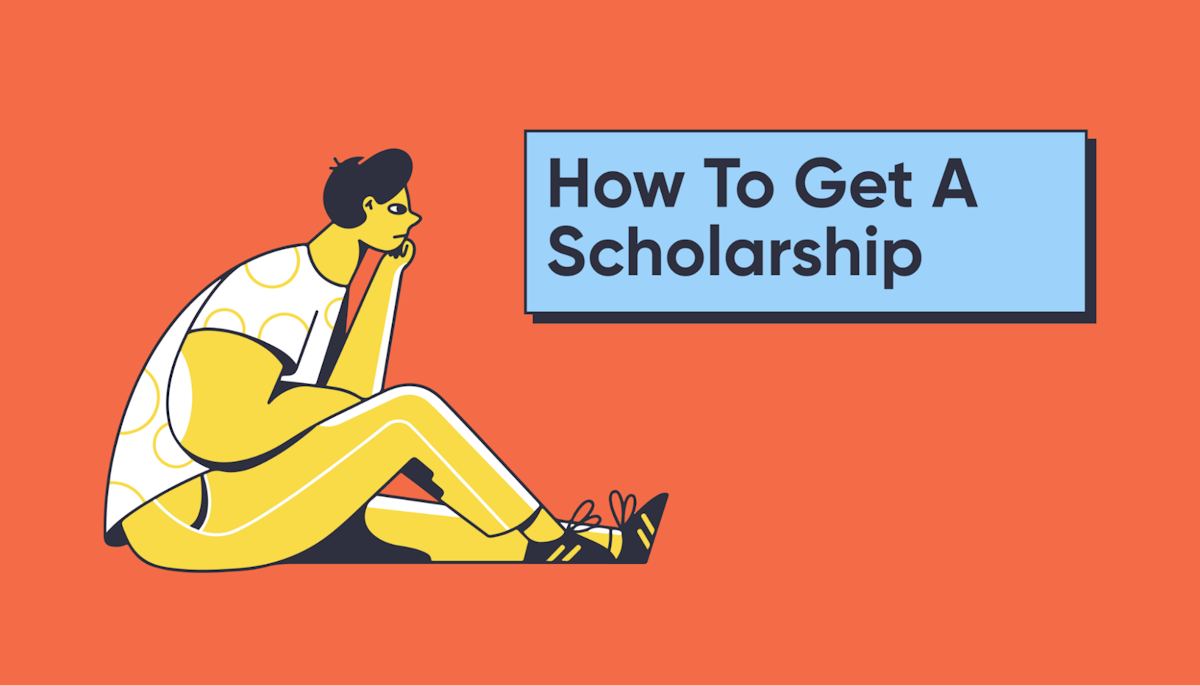Scholarships •
February 28, 2023
How to get a full ride scholarship
Learn about what a full ride scholarship is, what criteria are considered, and how you can get one.
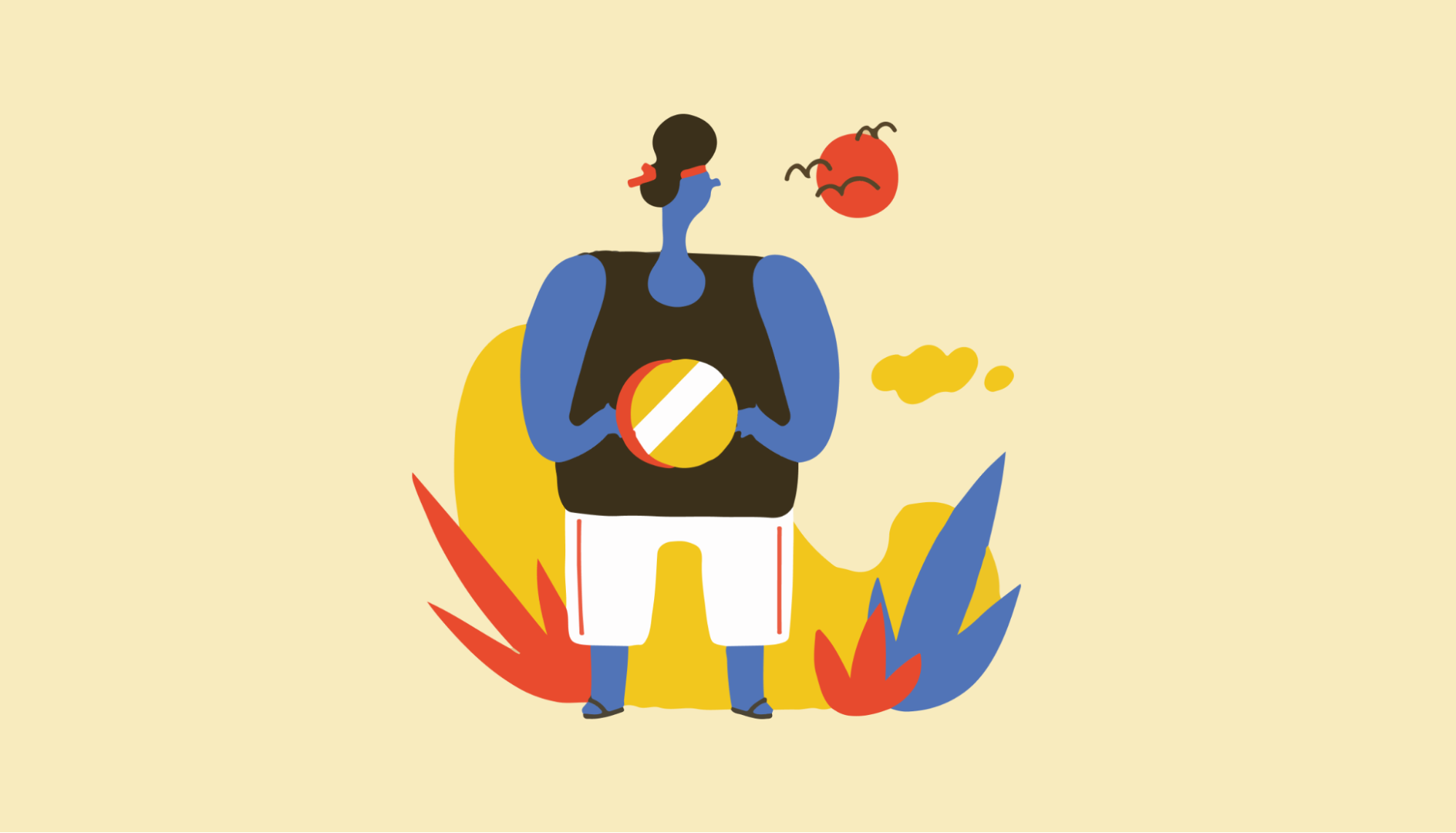
College is a worthwhile investment—but you need money to make that investment.
With the average cost of a 4-year degree at a public university at $103,456, you may feel that a college degree is out of your reach.
The reality is that there is plenty of financial aid out there to help you pay for college expenses. In fact, getting a full ride scholarship that pays for all of your college expenses is possible!
Let’s discuss what a full ride scholarship is and the different types. We’ll also walk you through how to get a full ride scholarship.
What is a full ride scholarship?
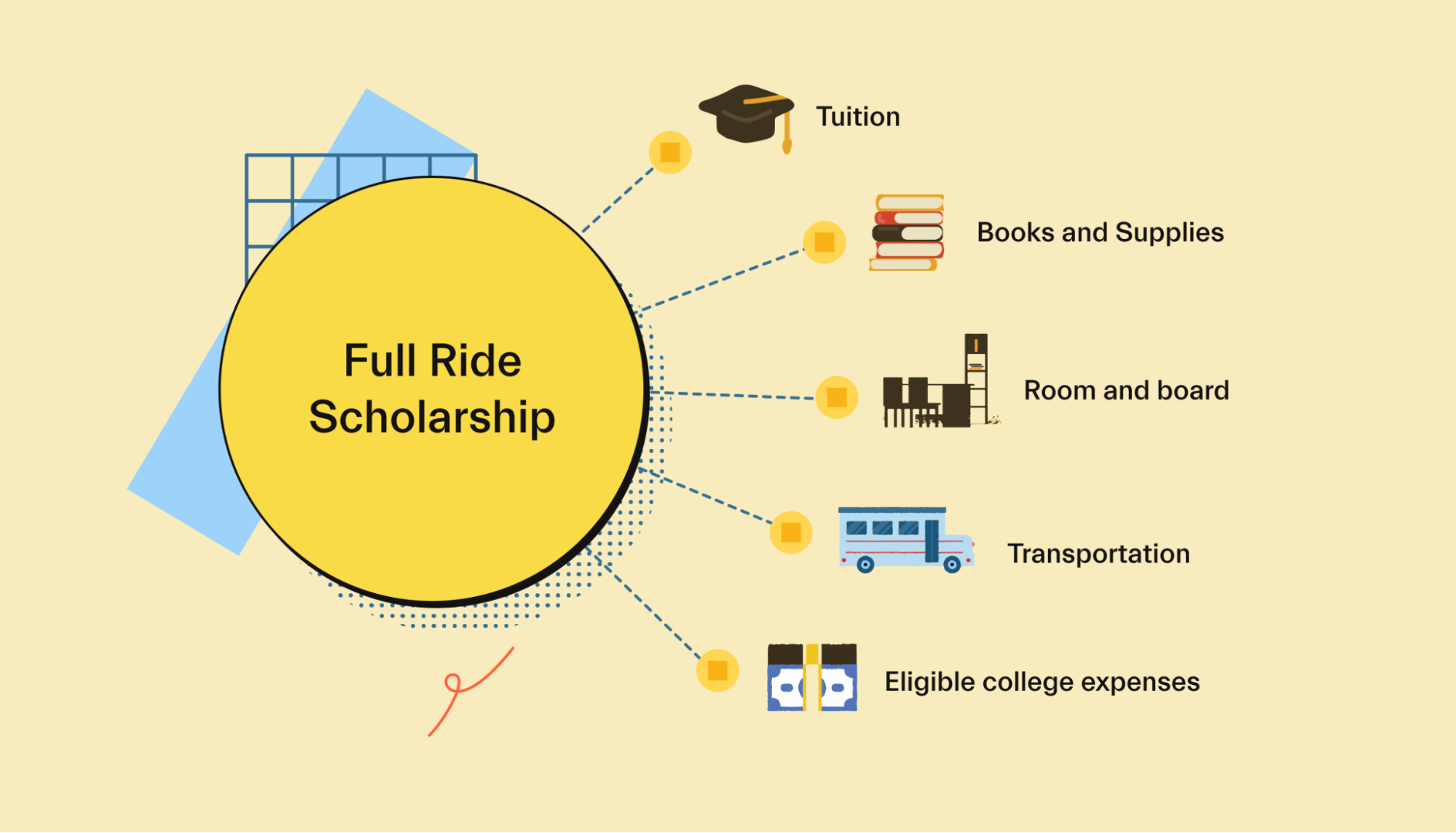
A full ride scholarship is a type of scholarship that pays for all of your college expenses! A full ride scholarship program typically covers tuition, books and materials, and room and board expenses.
The full list of eligible expenses in a full ride scholarship varies by school. Additional college expenses may include a living stipend (allowance), a stipend for a summer study-abroad program (to help you cover living costs while abroad), and funds to do research.
Some of the benefits of a full ride scholarship aren’t monetary. For example, a full ride scholarship may provide you early access to choose a residence hall. Another non-cash benefit could be an honorary club or honors program invitation.
Like other scholarships, a full ride scholarship is free financial aid. You don’t have to pay back this free money as long as you meet the requirements of the organization issuing the scholarship.
Typical requirements include maintaining a minimum GPA, enrolling in a specific program, and attending school at least part-time.
How many college students get a full ride scholarship?
Getting a full ride scholarship is very competitive—fewer than 1% of college students get one.
Let’s put things in perspective: from the 20 million students attending college every year, about 200,000 would get a full ride scholarship. Still, it’s possible.
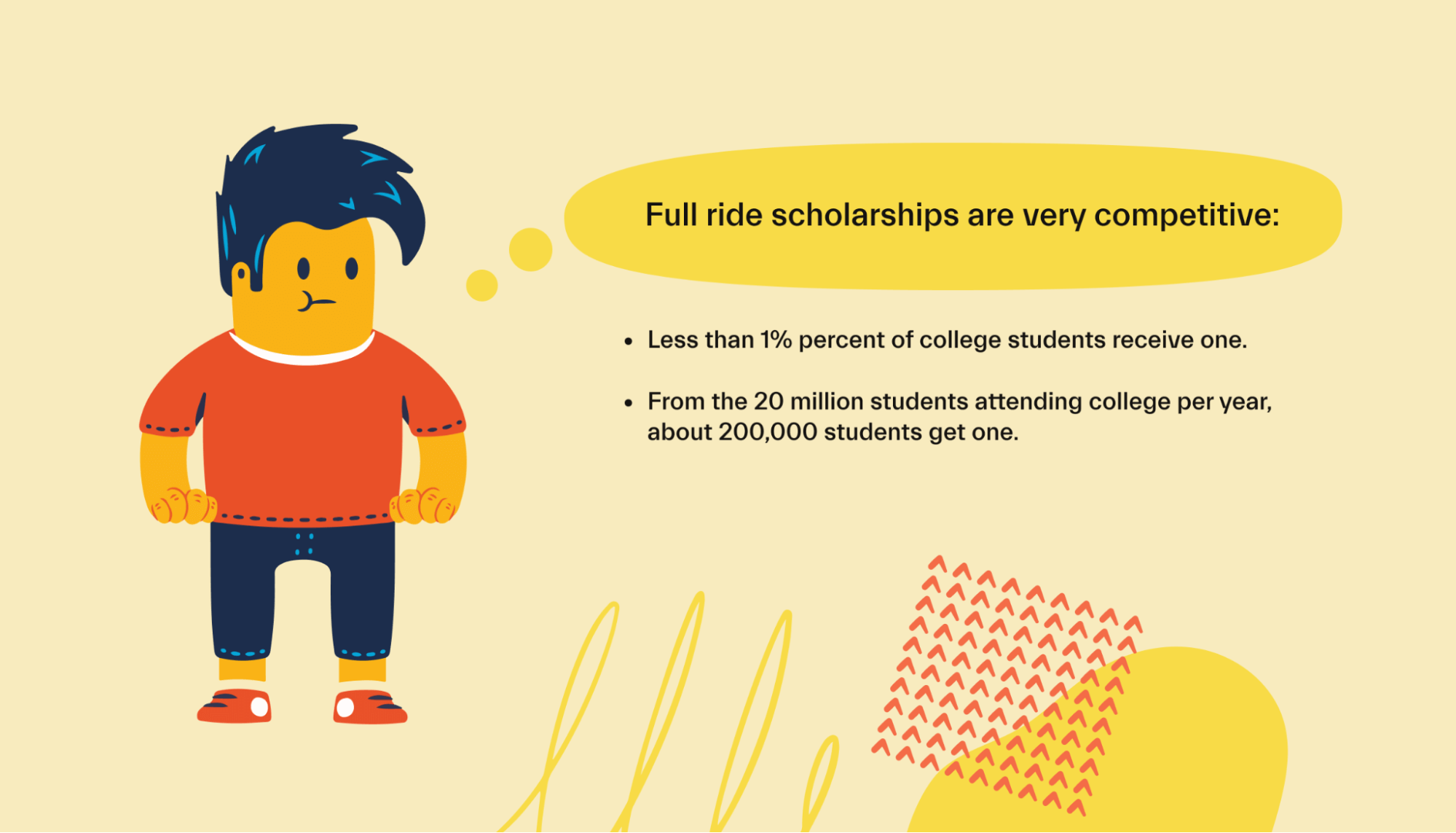
Plus, about 5 million scholarships are available to college students each year—that’s a total of $24 billion in free financial aid! So get your name out there and get some of that free money.
Is a full tuition scholarship the same as a full ride scholarship?
No, a full tuition scholarship is different from a full ride scholarship.
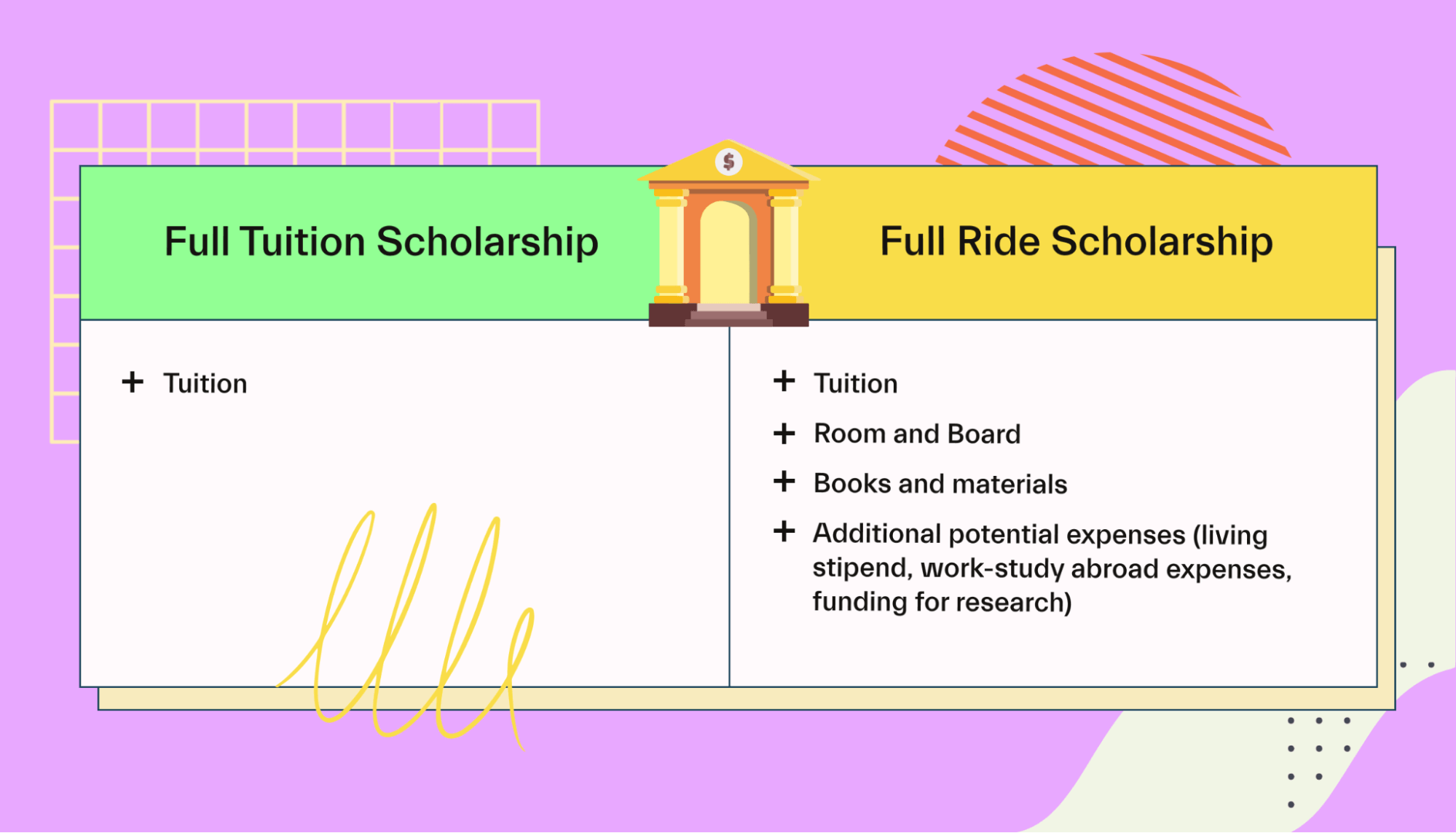
A full tuition scholarship only covers the entire cost of tuition. A full ride scholarship also covers other college-related expenses, such as housing and books.
How do you qualify for a full ride scholarship?
The requirements to be eligible for a full ride scholarship vary. The college or organization sponsoring the full ride scholarship determines the eligibility criteria and application process.
Most full ride scholarships are merit-based scholarships—free financial aid for students who show outstanding academic achievement, athletics, or other unique skill sets.
The standard selection criteria for full ride scholarship selection committees are:
High school transcript (GPA, list of subjects, and level of academic rigor, e.g., advancement placement (AP) classes)
Scores from the Scholastic Assessment Test (SAT), American College Testing (ACT), or other standardized tests
Essays and personal statements
Letters of recommendation
Extracurricular activities (e.g., community service, sports, music, part-time employment or internships, and other activities)
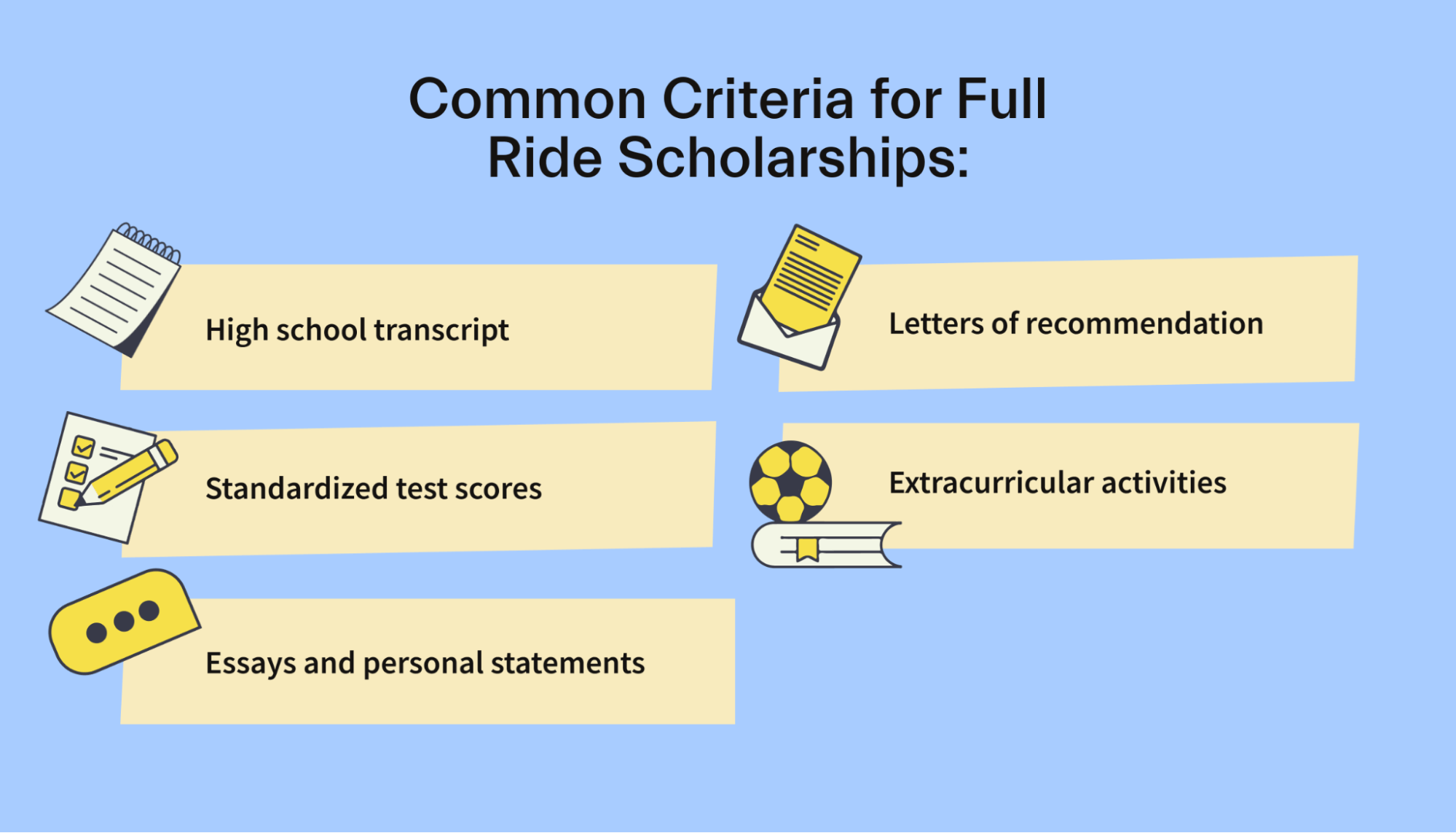
Some colleges and organizations will also have you do one or more interviews with members of the selection committee.
Are full ride scholarships only merit-based scholarships?
No, good grades play an important role, but it’s not the only factor.
Some full ride scholarships are only available to students with a specific heritage, employment affiliation (student or parent of student works for a company), residency in a specific community, or plan to pursue a specific major or career plan.
Other full ride scholarships are need-based scholarships—financial aid that requires you to demonstrate the need for financial support.
The school or organization giving you the scholarship may ask you to submit documents to verify your financial situation in addition to completing the Free Application for Federal Student Aid (FAFSA).
Does graduating at the top of my high school class guarantee me a full ride scholarship?
Graduating as valedictorian or at the top of your high school class definitely gives you a scholarship opportunity. Still, it doesn’t guarantee you a full ride scholarship. There are simply not enough full ride scholarship opportunities for every high-achieving high school senior to get one.
In addition to academic excellence, schools and organizations consider other factors, such as essays, personal statements, letters of recommendation, and extracurricular activities.
Balancing out your application by meeting all the selection criteria is a great idea. This way, you’ll maximize your chances of getting a full ride scholarship.
What are the types of full ride scholarships?
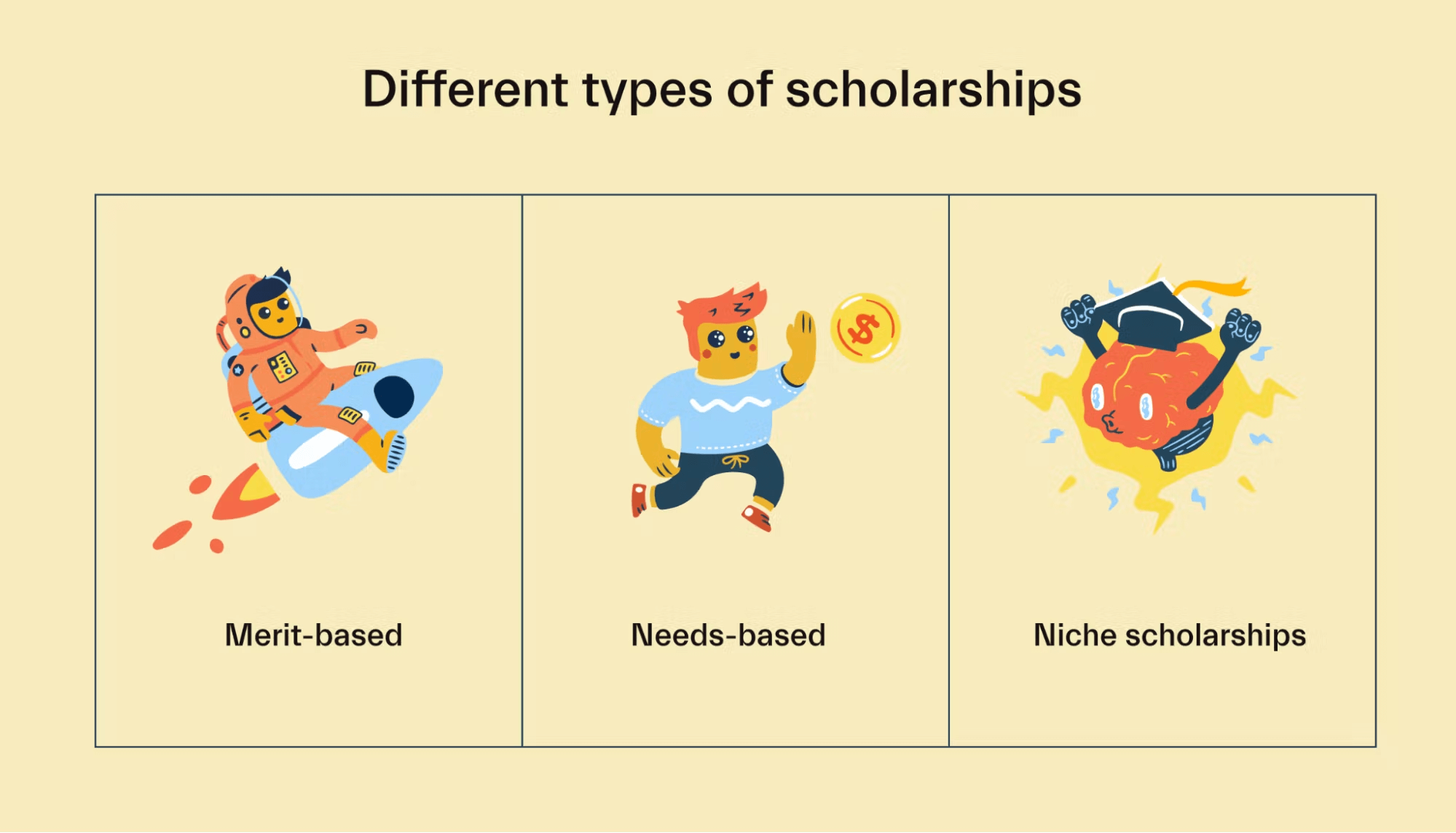
The types of full ride scholarships are athletic, need-based, government, merit-based, and state-sponsored.
Let’s break them down.
Athletic full ride scholarships
The National Collegiate Athletic Association (NCAA) estimates that from the 8 million high school athletes, only approximately 500,000 become college athletes.
The high level of competition to attract college athletes is why NCAA schools award close to $3.5 billion in athletic scholarships every year. Some of these athletic scholarships are athletic full ride scholarships.
A school may offer an athletic scholarship to recruit top talent for its sports teams.
Need-based full ride scholarships
Some full ride scholarships are available to lower-income students to help them pay for college.
Top-tier colleges often offer need-based full ride scholarships to widen their pool of applicants and create a more inclusive academic experience. A need-based full ride scholarship enables some students who can’t pay for college on their own to access quality higher education.
Niche-based full ride scholarships
Niche scholarships are a type of award designed for specific groups of people. They’re often for relatively small amounts, but if you’re lucky, you might find one that awards the full cost of tuition.
For example, there are scholarships for vegetarians or left-handed people that usually award a few hundred to a thousand dollars.
Government full ride scholarships
The federal government is the main source of financial aid for college students.
The federal government awards full ride scholarships to eligible military academy students and Reserve Officers' Training Corps (ROTC) students. For example, the Air Force ROTC Type 1 scholarship pays 100% of tuition and fees at any public or private school with an Air Force ROTC detachment. It also provides recipients an annual book stipend and a monthly living stipend.
In addition, active and retired military members can use their GI Bill benefit to cover all or most of their education costs and training.
Merit-based full ride scholarships
Merit-based scholarships are the most common type of full ride scholarships.
Merit-based full ride scholarships require you to show academic excellence through your GPA, SAT score, and/or ACT score. Since you need academic merit for a merit-based scholarship, this type is also called an academic scholarship.
Some merit-based full ride scholarships are for students with a special skill set, such as musical ability, leadership potential, or artistic talent.
State-sponsored full ride scholarships
Besides the federal government, state governments also provide scholarships.
Every year, states give $14.2 billion in financial aid to about 1/3 of college students.
State-sponsored full ride scholarships vary by state. Some scholarship programs allow you to use financial aid at any college within the state.
Other programs may limit eligible schools within a specific school system within the state.
What colleges offer full ride scholarships?
Both public and private colleges offer full ride scholarships and full tuition scholarships. Some of these full-tuition scholarships have the potential to turn into full ride scholarships.
Let’s review a list of some of them.
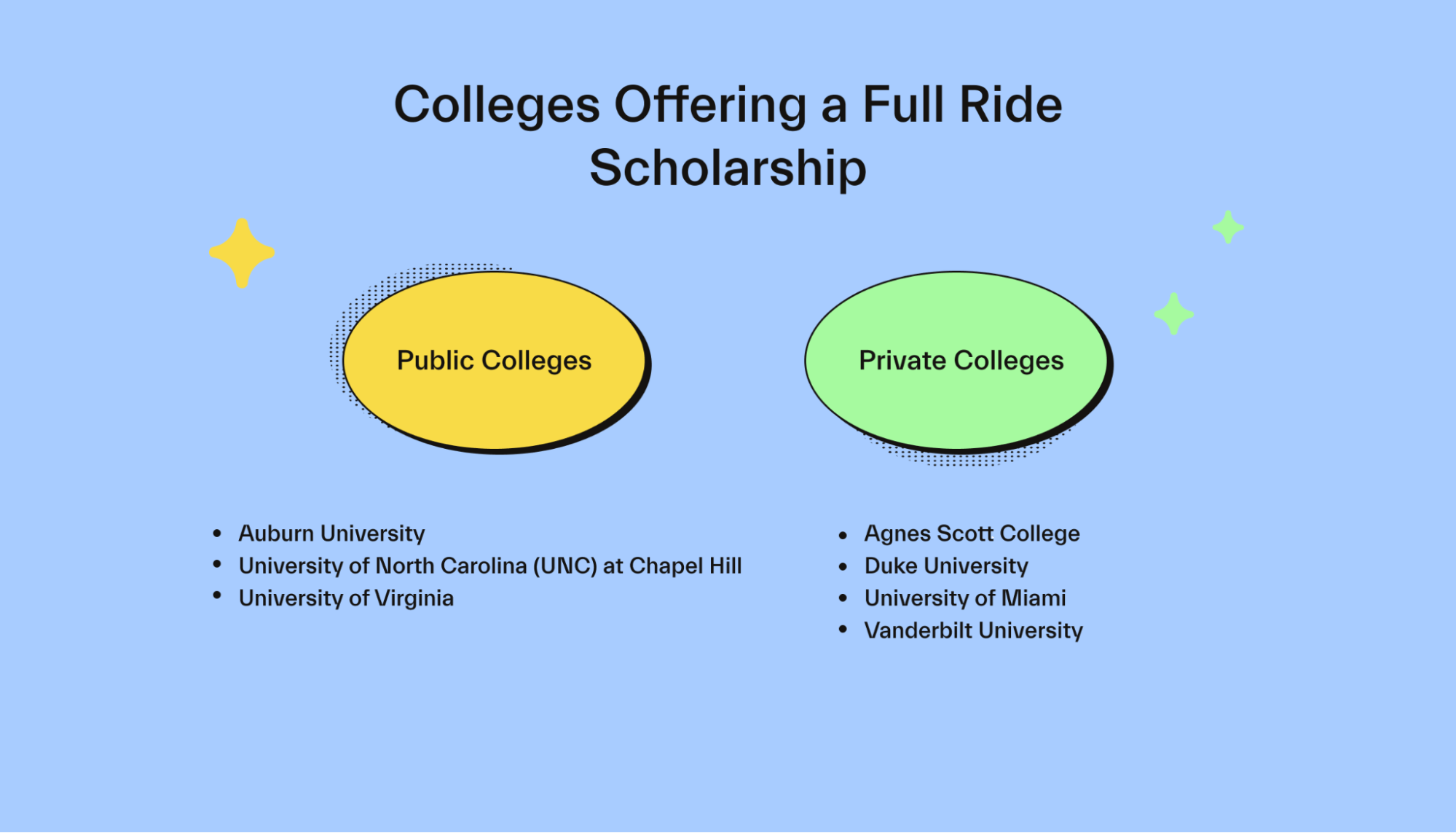
Public colleges offering full ride scholarships
First, look at some public colleges that offer full ride scholarships.
Auburn University
The National Merit Scholarship Competition is a national merit-based competition that rewards top scorers of the PSAT. This test is typically taken when you are a high school junior.
Finalists of this competition who live in Alabama can apply for the National Scholars Presidential Scholarship. This merit-based full ride scholarship covers $42,000 in college expenses over 4 years at Auburn University.
University of North Carolina (UNC) at Chapel Hill
UNC-Chapel Hill offers several merit-based full ride scholarships to in-state and out-of-state students. Even an international student can qualify for a full ride scholarship opportunity!
The Robertson Scholars Leadership Program is a full ride scholarship that pays for 8 semesters at UNC-Chapel Hill. You can also use this full ride scholarship at Duke University.
This scholarship pays for full tuition, room and board, and the majority of required fees. The program also provides a stipend for up to 3 summer experiences within the US, funding for study-abroad programs, and funding for attending conferences.
University of Virginia
The University of Virginia offers 2 merit-based full ride scholarships.
The Jefferson Scholarship and the Walentas Scholarship cover the entire cost of college at the University of Virginia. These full ride scholarships offer stipends for all expenses, including books, room and board, required fees, and personal expenses.
The total value of the full ride scholarship is over $293,000 for out-of-state residents and $157,000 for in-state residents.

Private colleges offering full ride scholarships
Now, let’s look at some private colleges that offer full ride scholarships.
Agnes Scott College
The Goizueta Foundation Scholarship, offers one need-based full ride scholarship each year to a new first-year student.
This scholarship covers all expenses for tuition and room and board for 4 years of studies. The selection committee gives priority to Hispanic students.
Duke University
Duke University offers 9 merit-based full ride scholarships that cover tuition and room and board.
The Robertson Scholars Leadership Program is a full ride academic scholarship that pays for 8 semesters at Duke University. You can also use this full ride scholarship at the University of North Carolina at Chapel Hill.
University of Miami
The University of Miami, offers 2 merit-based full-tuition scholarships to incoming first-year students.
The Isaac Bashevis Singer Scholarship covers 4 years of undergraduate studies at the University of Miami. It is open to all students, including international students.
The Ronald A. Hammond Scholarship is also a full tuition scholarship. Still, it’s only available to US permanent residents and citizens.
Vanderbilt University
The Cornelius Vanderbilt Scholarship is a full tuition award that has the potential to become a full ride scholarship.
By default, this merit-based scholarship covers the full tuition at Vanderbilt University and the cost of a summer experience after either the second or third year. This scholarship is also a need-based scholarship for students who demonstrate financial need.
Northeastern University
Each year, Northeastern selects a small number of its most accomplished enrollees to apply to receive the Stamps Scholarship.
Stamps Scholars receive a full ride scholarship and financial assistance with research, travel, and mentorship.
Boston University
Top applicants at BU can obtain a competitive scholarship known as the Trustee Scholarship, offering a full ride that covers tuition and fees. There are only 20 recipients of the Trustee Scholarship each year.
The selected students join a unique campus community and get to interact with the school’s other top students regularly.
How do you get a full ride scholarship?
With the potential to cover the entire cost of your degree, finding out how to get a full ride scholarship is a worthwhile investment.
Here are the steps to get a full ride scholarship.
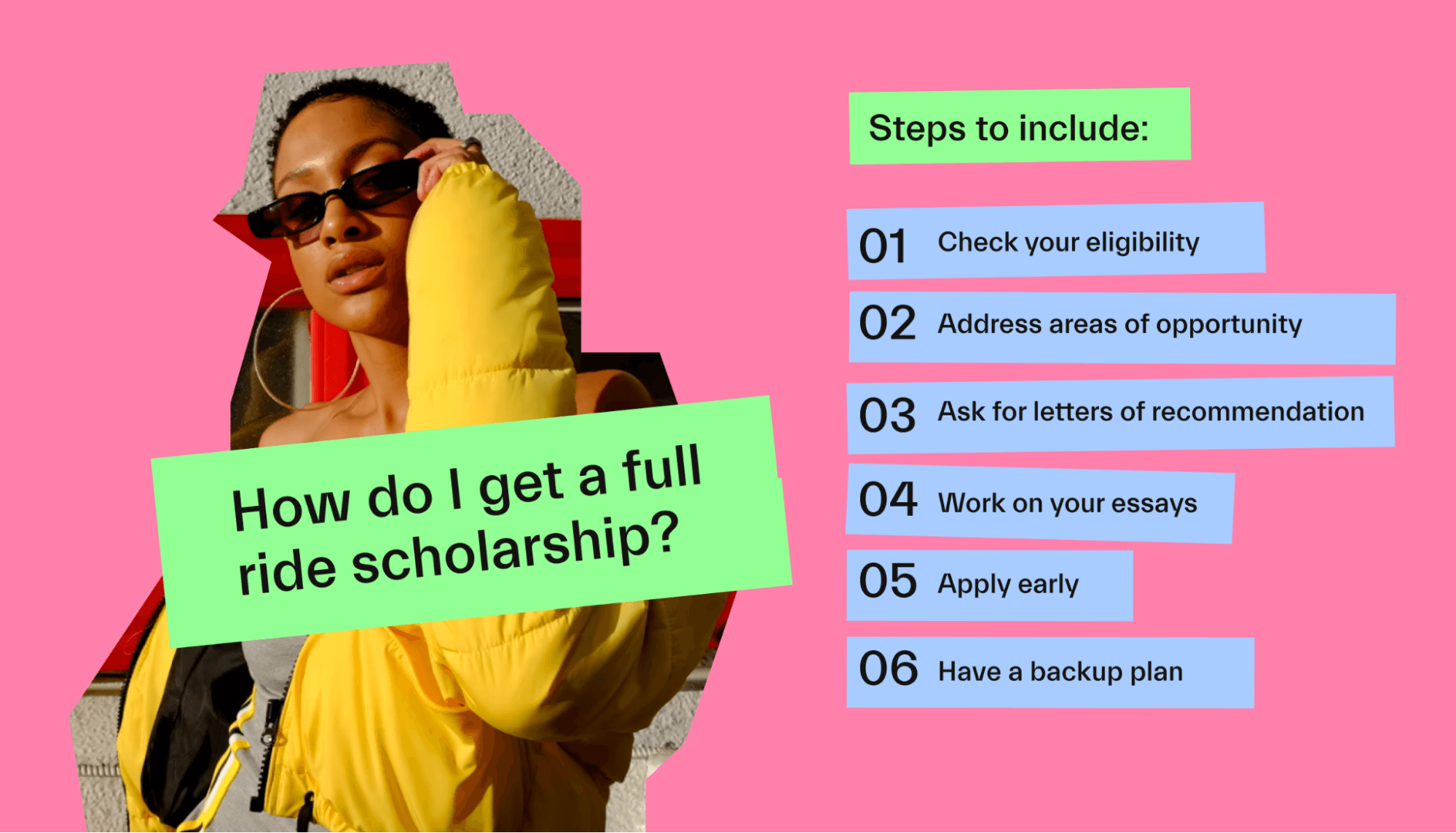
1. Check your eligibility
The first step to getting a scholarship is finding out what you’re eligible for.
Your heritage, residence, parent’s employment, financial situation, and other factors influence your eligibility for full ride scholarships.
Review the requirements for full ride scholarships at the colleges that you’re applying to. Also, find out if you meet the criteria from sponsoring organizations, corporations, and government agencies in your state.
Checking your eligibility is an important step to maximize your chances of getting a full ride scholarship.
2. Address areas of opportunity
Academics play an essential role in eligibility for full ride scholarships. So, study hard and keep up your cumulative GPA if you’re still working on your high school diploma.
Remember that you can typically take the SAT in your junior and senior years. Check with your counselor to determine a competitive SAT score for your state’s high school system. If you need to retake the SAT, start prepping right away.
Keep an eye on special requirements, including leadership skills and community service. Invest the time in getting the necessary experience to meet those requirements.
3. Ask for letters of recommendation
Most applications for full ride scholarships require one or more letters of recommendation.
Look at your network of counselors, teachers, mentors, and supervisors. It’s a best practice to seek a recommendation from someone who’s spent a lot of time supervising or interacting with you directly.

4. Work on your essays
Remember to customize every essay to the specific requirements of the scholarship you’re applying to. For example, for a scholarship program that focuses on citizenship and service, you might want to write about an impactful volunteer experience you had. For one that focuses on a specific academic field, talk about your interest or experience in that field.
The more people that review your essays and personal statements, the better. So, ask your friends and family to read through them before you send them off. Your goal is to complete a letter that reads easily and gets your points across well.
5. Apply early
Since funding may run out and some scholarships are on a first-come basis, aim to complete your application by the preferred or early bird deadline.
6. Have a backup plan
Apply for additional scholarships—even the ones that aren’t full ride scholarships. Some of them are easy scholarships that require little effort to apply for.
By applying for all the scholarships you’re eligible for, you may end up with a series of scholarships that cover all or most of your college expenses.
Are there limits on how you can use scholarship money?
Yes, most scholarships have restrictions on how to use the money.
Many schools that offer full ride scholarships will automatically apply the scholarship to your student bill. That means you won’t have the opportunity to use the funds to pay for living expenses beyond, possibly, on-campus room and board.
Scholarship recipients who get their awards from outside sources may be able to put the money toward living expenses on top of using it to pay for tuition.

Can you lose your full ride scholarship?
Yes, sometimes it’s possible to lose a full ride scholarship after you’ve earned it. However, this does not happen often or without warning.
Scholarship programs usually have set eligibility requirements, such as maintaining a minimum grade point average, attending mandatory events, or even being a US citizen. To renew your scholarship, you need to keep meeting those eligibility requirements.
If you fail to meet the requirements, you could lose the scholarship.
Suppose you’re in danger of falling below a required grade point average, for example. In that case, it’s imperative that you speak to someone from your financial aid office. They can tell you how your grades will impact your package of financial assistance or work with you to help you regain your eligibility.
Conclusion
A full ride scholarship is within reach for many students. Several public and private colleges offer one. So a scholarship opportunity is definitely within your grasp.
While academics play an important role, most full ride scholarships consider non-academic skills like athletics, community service, and everything in between.
Plus, not all scholarships are merit-based, some consider your financial situation the main benchmark.
Since there’s a limited number of these types of scholarships, it’s important to plan and apply early.
Mos makes it easy to find the best financial aid and scholarship opportunities for you! Explore memberships today.
Let's get
your money
- Get paired with a financial aid expert
- Get more money for school
- Get more time to do you





